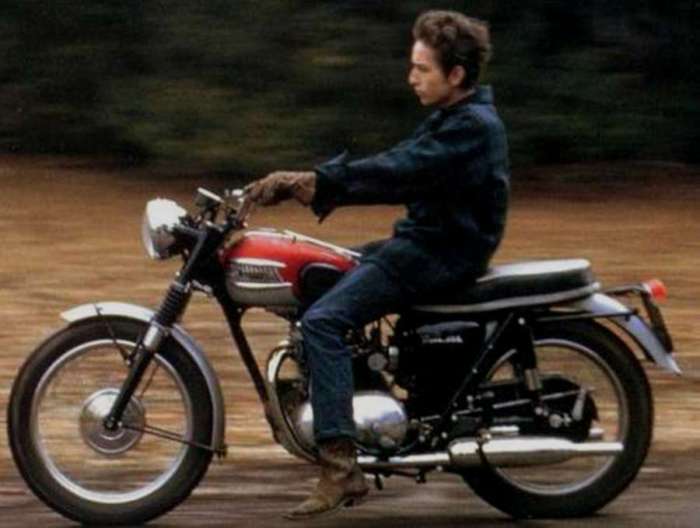The sun got in his eyes. The bike slipped on an oily patch. He flew off the bike. He simply tipped over. He broke his back. He got a concussion. That is, unless he didn’t really hurt himself. Or maybe the crash was a tall tale.
50 years ago on July 29, 1966 Bob Dylan tumbled off his Triumph on a sunny Friday morning. The musician holed up in the mountains of upstate New York for months afterward, significantly changing the course of his career’s ride.
This is the most analyzed motorcycle crash in pop-culture history and, just as the true meaning of Dylan’s lyrics, it’s hard to pin down.
Dylan has talked about the crash, but often in general terms. “I had been in a motorcycle accident and I’d been hurt, but I recovered,” he wrote in his memoir, “Chronicles.” The few witnesses have remained tight-lipped.
All the ambiguity surrounding this accident that clearly marked his life and career has lead it to take on near mythic dimensions.
When something’s not right, it’s wrong
Initial reports were confusing.
A two-sentence story was published four days after the accident in the New York Time with a headline “Dylan Hurt in Cycle Mishap”. It said he was under a doctor’s care. As Dylan got lost and was nowhere to be seen the following months, rumors sprouted that he was heavily injured, disfigured and bind even. Over the years, Dylan himself indicated that he broke a vertebra and got a concussion.
There is no official record of the crash because there is no police report.
It’s possible Dylan crashed shortly after pulling out of the Woodstock home of his manager, the late Albert Grossman. Howard Sounes writes in “Down the Highway” that Dylan was being followed in a car by his wife, Sara, who took her injured husband back to Grossman’s house.
Grossman’s wife, Sally, was there and saw Dylan “kind of moaning and groaning” but noticed no obvious signs of injuries, according to Sounes.
A likely spot for the crash is along or near Striebel Road, a winding, hilly ribbon of road running by that house.
Shelter from the storm
Dylan was driven about an hour to Middletown to the home of a doctor he knew, Dr. Ed Thaler.
Dylan arrived “very upset,” the doctor’s widow, Selma Thaler, said in an interview with The Associated Press. “He didn’t want to go to the hospital, so we said, ‘You can stay here.'”
Dylan stayed in a third-floor bedroom of the Thaler home for about a month, eating dinner with the family and having friends over on Friday nights, including Allen Ginsberg and the musicians who would later become famous as The Band. They showed a movie on the living room wall. She thinks it was the Dylan documentary “Don’t Look Back.”
Dylan was sweet and quiet, Thaler said, but she can’t recall him showing any visible signs of injury. She believes he broke his neck.
World gone wrong
The accident gave Bob Dylan a chance to hit the reset button and revive himself.
By 1996, he had gone from a fresh faced folkie to the voice of the ‘60s generation – and he was uncomfortable with it. Woodstock had become a “nightmare,” with moochers at his door and goons breaking in. “Everything was wrong, the world was absurd,” he wrote in his memoir.
Some fans and Dylan historians have suggested that this motorcycle accident may have saved the musician’s life. He was completely exhausted from constant touring and, according to some people, he had been taking large amounts of amphetamine while on the road in 1966.
After the accident, tour dates were put off, and he lay low in Woodstock.
Dylan told a New York Daily News reporter who found him there in May 1967 that he’d been seeing close friends, “poring over books by people you never heard of” and thinking about where he was going.
Now you don’t talk so loud
Dylan went silent after the crash. He would not tour again for years, and his next album wasn’t released until December 1967.
However, he was writing and making music quietly by early 1967. He and the musicians of The Band recorded at Dylan’s house, and later at a garishly painted home rented by band members in nearby Saugerties dubbed “Big Pink.” Bootleg recordings from this time were eventually released in 1975 as “The Basement Tapes,” and then as part of a deluxe box set in 2014. They include some of Dylan’s most haunting and enigmatic songs, among them “I Shall Be Released,” ”Tears of Rage” and “This Wheel’s on Fire.”
Critics now view this creative period outside the spotlight as a vital step in Dylan’s evolution.
The answer, my friend, is blowin’ in the wind
Dylan and his family moved to New York City’s Greenwich Village by 1970, leaving Woodstock in his rear-view mirror.
In interviews over the decades, Dylan has offered some details — sun in his eyes, flying off the bike. But he dwells more on how it marked the end of a busy and unsustainable period in his life.
Dylan is now a 75-year-old artist who tours regularly and has put out dozens of albums. The accident is a long-ago footnote in a lengthy career, but there’s evidence that Dylan did indeed look back at least once.
He came back to visit Thaler’s house about four years ago, she said. He stopped with some of his band members before a show in the area, revisiting the house in which he took shelter that morning in 1966.
(Source: Yahoo)
Photo by mtarvainen 







